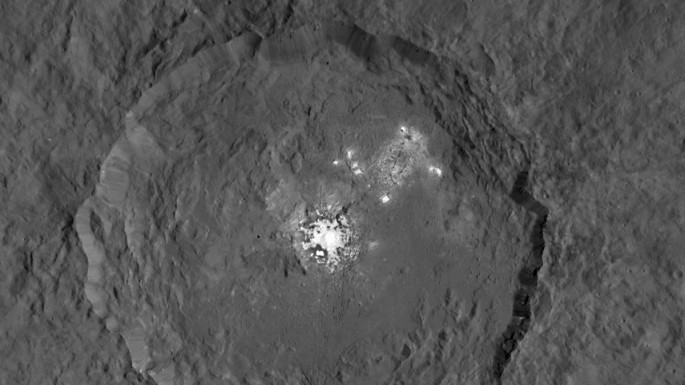Mysterious, bright spots are observed inside a crater on the surface of the dwarf planet, Ceres that is located in the major asteroid belt between Mars and Jupiter. To date, NASA's Dawn spacecraft is now just 915 miles away from its surface that is currently undergoing a mapping phase of the dwarf planet. The probe will then descend to its surface at a 230 mile distance later this year.
As Dawn approached Ceres, these bright spots were first detected by the probe's suite of scientific instruments where mission controllers speculate about possible ice or salt deposits or even volcanic or ice geyser geology or even impacts that deposited material deep within its subsurface, revealing a younger, brighter layer.
However, this latest image now reveal surface features measuring 450 feet across. The two prior bright spots are now grouped into one very bright area located in the center of the crater named Occator, where the crater also consists of eight smaller concentrations on one side.
Researchers are still stumped about the origins of this extremely bright material or how it got there inside the Occator in the first place. According to Dawn deputy principal investigator, Carol Raymond of NASA's Jet Propulsion Laboratory, even if data reveals higher resolution, the team is still looking for missing pieces of information to gain the whole picture.
Raymond adds that these missing pieces of information are essentially the details of the chemistry of these deposits. After completing spectral mapping and conducting a full analysis of that data, then we will get some answers as Dawn also flies closer to the surface, to determine if these bright materials are made of one or many materials.
The spacecraft arrived at Ceres last March where it is gradually spiralling down to lower altitudes. Right now, the probe reached its high-altitude mapping orbit where the probe will now continue its descent to the surface of the planet at 230 miles.
Raymond reveals that the surface of the dwarf planet is truly an enigma, it is unlike any other body in the solar system. She also considers that Dawn's sharper images are like "peeling an onion", revealing more intensive data.
Dawn's current stage of the mission is to map the entire surface of Ceres six times on its current orbit to obtain stereo views and surface features applied on 3D maps. The mission will continue until June 2016.



























